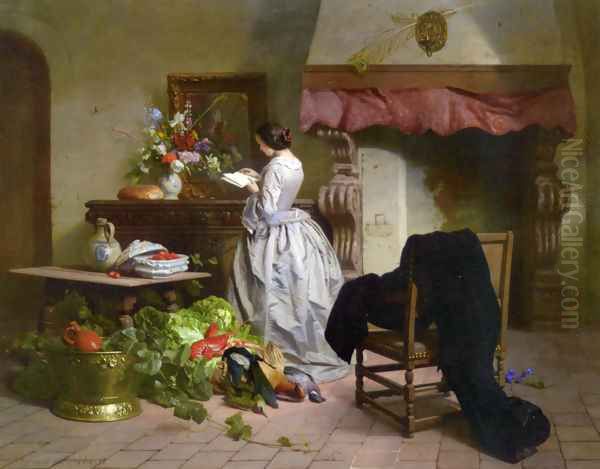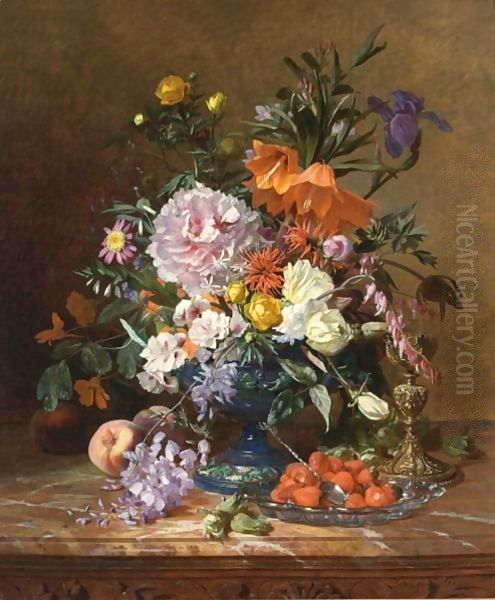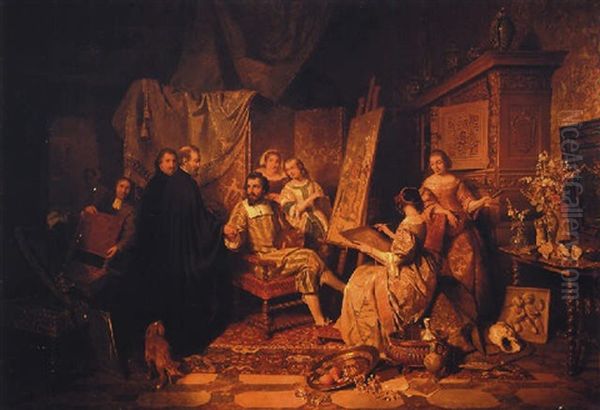David Emil Joseph de Noter (1825-1892) stands as a significant, if sometimes overlooked, figure in the rich tapestry of 19th-century Belgian art. A painter renowned for his exquisite oil paintings, particularly his still lifes and intimate interior scenes, de Noter carved a distinct niche for himself through a masterful synthesis of meticulous realism and an evocative, almost dreamlike atmosphere. His canvases are celebrated for their sophisticated interplay of color and light, transforming everyday objects and scenes into compositions brimming with emotional depth and a palpable sense of presence. His work, while firmly rooted in the observational traditions of his Belgian and Dutch artistic heritage, also whispers of the romantic sensibilities prevalent in his era.
The Artistic Milieu of 19th-Century Belgium
To fully appreciate de Noter's contributions, it's essential to understand the artistic environment from which he emerged. Belgium in the 19th century, having gained its independence in 1830, was forging a national identity, and art played a crucial role in this process. Academies in cities like Antwerp and Brussels were vibrant centers of artistic training, often emphasizing strong technical skills and drawing from the legacy of the great Flemish Masters like Peter Paul Rubens and Anthony van Dyck. However, the century also saw the influx of new ideas: Romanticism, with its emphasis on emotion and individualism, gave way to Realism, which sought to depict the world and its people with unvarnished truth. Later, Impressionism and Symbolism would also find fertile ground in Belgium.

Artists like Gustave Wappers and Nicaise de Keyser were leading figures in the Belgian Romantic school, often depicting grand historical scenes. Concurrently, a strong tradition of genre painting and still life, harking back to the 17th-century Dutch and Flemish Golden Age, continued to thrive. It was within this dynamic and evolving artistic landscape that de Noter honed his craft. While specific details about his early life and formal training remain somewhat elusive in readily available records, it is clear that he absorbed the prevailing emphasis on technical proficiency and the enduring appeal of finely rendered realism. The De Noter family itself appears to have had artistic inclinations; for instance, Peter Francis de Noter, likely a relative, was a painter born in Walhem, near Malines, and a student of the sculptor Van Geel, indicating a familial predisposition towards the arts.
The Signature Style: Light, Color, and Ethereal Realism
David Emil Joseph de Noter’s artistic signature lies in his extraordinary ability to imbue his subjects with a luminous quality. His paintings are not mere transcriptions of reality; they are interpretations, where light and shadow engage in a delicate dance, sculpting forms and creating a captivating ambiance. He possessed a profound understanding of color theory, employing subtle gradations, warm and cool contrasts, and harmonious palettes to evoke specific moods and enhance the visual poetry of his compositions. This "dreamlike" quality, often remarked upon in descriptions of his work, doesn't stem from fantastical subject matter but rather from this heightened, almost magical treatment of light and atmosphere.
His brushwork was exceptionally fine and controlled, allowing him to render textures with remarkable verisimilitude. Whether depicting the glistening skin of fruit, the delicate sheen of porcelain, the rich folds of fabric, or the polished surface of a wooden table, de Noter’s attention to detail was exacting. This meticulousness, however, never resulted in a cold or sterile academicism. Instead, it served to heighten the sensory experience of the viewer, drawing them into the intimate world of the painting. He masterfully balanced this detailed rendering with an overall sense of harmony and emotional resonance, ensuring that the technical skill always served the expressive purpose of the piece. This fusion of naturalistic detail with an almost romantic sensibility allowed him to create works that felt both grounded and transcendent.
Masterpieces of Still Life and Intimate Scenes

De Noter’s oeuvre includes a significant number of still life paintings, a genre in which he particularly excelled. Works such as Still Life: Fruits and Vegetables on a Table and Still Life: White Porcelain Vase, Fruits and Vegetables exemplify his talents in this domain. In these paintings, arrangements of everyday objects – plump fruits, crisp vegetables, gleaming ceramics, perhaps a pewter tankard or a reflective glass – are transformed into subjects of profound beauty. He didn't just paint objects; he captured their essence, their tactile qualities, and the way light interacted with their surfaces. These compositions often suggest abundance and the quiet pleasures of domestic life, continuing a tradition beloved by 17th-century Dutch masters like Jan Davidsz. de Heem or Willem Kalf, whose influence can be discerned in de Noter's work.
Beyond pure still life, de Noter also created captivating interior and genre scenes. La Lecture (The Reading), dated 1858, is a prime example. While the specific imagery might involve a figure absorbed in a book, one can imagine the scene rendered with his characteristic attention to the textures of the room, the play of light filtering through a window, and the quiet, contemplative mood. Such paintings often feature a strong still life component within the broader narrative, showcasing his skill in integrating figures and their environments. A Maid in the Kitchen is another title that suggests a focus on domestic interiors, offering a glimpse into the everyday lives of 19th-century households, a theme also explored by contemporaries like Henri de Braekeleer, the son of Ferdinand de Braekeleer, known for his intimate and atmospheric Antwerp interiors.
Another notable work, Les Apprêts du festin (The Banquet Preparations), dated 1848, further illustrates his engagement with genre scenes. This painting, depicting the lively activity of preparing for a feast, would have provided ample opportunity for de Noter to display his skill in rendering a multitude of textures, from foodstuffs to kitchen implements, and perhaps figures in motion. It is particularly interesting as it is noted as a collaborative effort with Henri Leys, a highly respected Belgian painter known for his historical and genre scenes, often imbued with a meticulously researched historical accuracy and a style influenced by 16th and 17th-century German and Flemish painters.
Influences and Artistic Lineage
The influence of 17th-century Dutch and Flemish masters on de Noter's work is undeniable. The rich tradition of still life painting from this Golden Age, with artists like Willem Claeszoon Heda, Pieter Claesz, Rachel Ruysch, and the aforementioned de Heem and Kalf, set a high bar for realism, complex compositions, and often, symbolic meaning. De Noter clearly studied and absorbed these lessons, adapting them to the sensibilities of his own time. His meticulous rendering of textures, his sophisticated use of chiaroscuro, and his ability to elevate humble objects to subjects of artistic contemplation all echo this esteemed lineage.

However, de Noter was not merely an imitator. He infused his work with a 19th-century sensibility, a certain romantic softness, and a focus on light that, while precise, also carried an emotional charge. His approach can be seen as part of a broader 19th-century revival of interest in the "Little Masters" of the Dutch Golden Age, a trend visible across Europe, including among French artists like Jean-Baptiste-Siméon Chardin (though earlier, his spirit endured) and later, more academic realists.
De Noter and His Contemporaries: A Network of Artistry
David Emil Joseph de Noter operated within a vibrant artistic community. His collaboration with Henri Leys on Les Apprêts du festin is a clear testament to his interaction with prominent peers. Leys himself was a towering figure in Belgian art, later becoming a baron, and his historical genre scenes were highly influential. The nature of their collaboration – perhaps de Noter focusing on the still life elements while Leys handled the figures – was a common practice in earlier centuries and speaks to a mutual respect for specialized skills.
Another documented interaction involves Ferdinand De Braekeleer the Elder, a notable painter of genre scenes often depicting everyday life with humor and warmth. It is recorded that Leys was sometimes asked to "touch up" or enhance works by other artists, and among those whose paintings he worked on were pieces by David de Noter, possibly at the request of patrons or dealers seeking the cachet of multiple skilled hands, or perhaps for Ferdinand De Braekeleer himself. This indicates de Noter's recognized skill in specific areas, particularly still life, which could complement the figural work of others.
The artistic landscape of Belgium and nearby Paris, where de Noter also exhibited, was populated by numerous talents. In Belgium, artists like Alfred Stevens achieved international fame for his elegant depictions of fashionable women in luxurious interiors, sharing de Noter's eye for texture and detail, albeit in a different social context. Jean Robie was another Belgian contemporary who gained renown for his opulent flower paintings and still lifes, often featuring rich fabrics and precious objects, aligning with de Noter's thematic interests. David Col was known for his anecdotal genre scenes, often with a touch of humor, reflecting the broader Belgian interest in depicting everyday life.

In France, where de Noter exhibited at the prestigious Paris Salon, the art world was equally dynamic. The Realist movement, spearheaded by Gustave Courbet, was challenging academic conventions. While de Noter’s style was more polished and less overtly political than Courbet’s, the general emphasis on depicting the tangible world resonated. Other French artists excelling in still life or detailed genre scenes during this broad period included Antoine Vollon, known for his robust still lifes, and François Bonvin, whose work often depicted humble domestic scenes and still lifes with a quiet dignity reminiscent of Chardin. Even the great history and Orientalist painter Jean-Léon Gérôme, a dominant figure at the Salon, was admired for his incredible precision and illusionistic detail, a quality de Noter shared in his own domain. The Barbizon School painters, such as Jean-François Millet, though focused on rural landscapes and peasant life, also contributed to the broader current of realism.
Recognition and Accolades: A Mark of Distinction
De Noter's talent did not go unrecognized during his lifetime. He achieved notable success at the highly competitive Paris Salon, the most important art exhibition in the world at the time. In 1847, he was awarded a bronze medal, a significant acknowledgment for any artist, especially one from outside France. This was followed by an even more prestigious honor in his home country: a gold medal in Brussels in 1854. Such awards were crucial for an artist's reputation and career, leading to increased patronage, sales, and critical attention.
His participation and success in these major exhibitions indicate that his work appealed to the prevailing tastes of the time, which valued technical skill, refined aesthetics, and subjects that were both relatable and beautifully rendered. His ability to combine meticulous realism with a pleasing, almost poetic atmosphere likely contributed to his appeal among collectors and critics. He successfully navigated the art market of his day, establishing himself as a respected painter of still lifes and genre scenes.
Later Career and Enduring Legacy
David Emil Joseph de Noter eventually settled in Belgium, where he continued to produce works that captivated audiences with their blend of precision and poetry. He remained dedicated to his chosen genres, refining his approach to light, color, and composition throughout his career. While perhaps not as revolutionary as some of his avant-garde contemporaries, de Noter made a lasting contribution to the tradition of realist painting in the 19th century.
His legacy resides in the quiet beauty and technical brilliance of his canvases. He demonstrated that still life and intimate genre scenes could be vehicles for profound artistic expression, capable of evoking mood, delighting the eye, and offering a tranquil counterpoint to the often tumultuous narratives of history painting or the social commentary of more overtly Realist works. His paintings invite close looking, rewarding the viewer with their subtle details and the masterful handling of his medium.

In the broader history of art, de Noter represents a particular strand of 19th-century realism that valued craftsmanship, beauty, and a sensitive observation of the world. He successfully synthesized the rich heritage of Dutch and Flemish still life with the artistic currents of his own time, creating a body of work that continues to be appreciated for its elegance, technical mastery, and the unique, dreamlike quality that sets it apart. His paintings serve as a testament to the enduring power of finely observed and beautifully rendered depictions of the everyday, infused with an artist's unique vision and emotional sensibility. He remains an important figure for understanding the diversity and richness of Belgian art in an era of significant cultural and artistic transformation.